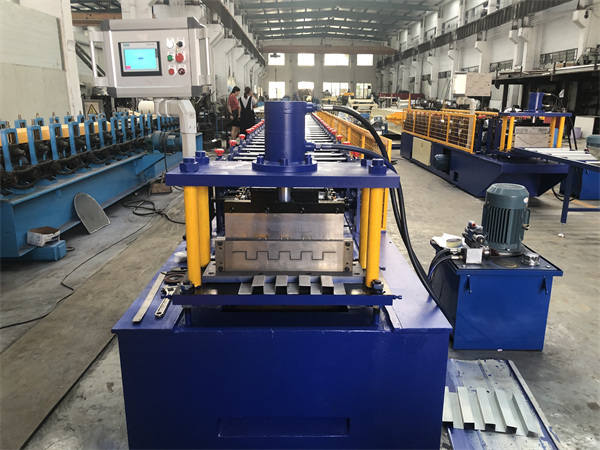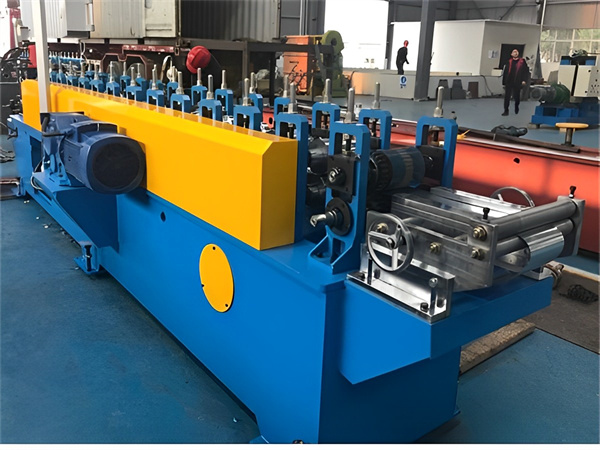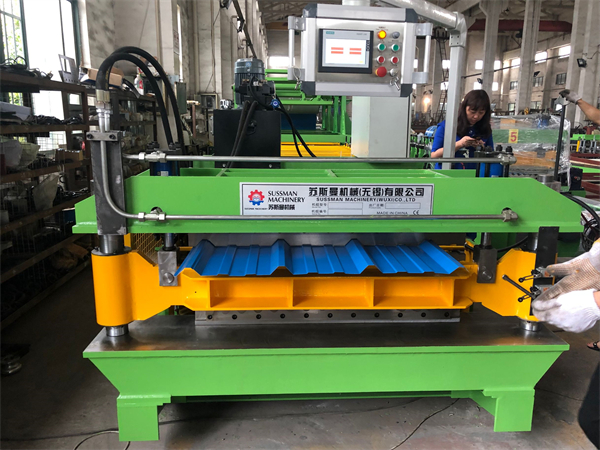1 परिचय
In the realm of modern metal fabrication, roll forming machines play a pivotal role in shaping various metal profiles with precision and efficiency. One such versatile machine that revolutionized the production of structural frames and profiles is the Frame Roll Forming Machine. In this article, we delve into the working principles, advantages, applications, and key components of the Frame Roll Forming Machine.
2. What is a Frame Roll Forming Machine?
A Frame Roll Forming Machine is a specialized industrial equipment designed to transform metal coils into continuous profiles with consistent cross-sections. This machine efficiently processes materials such as steel, aluminum, and other metals, yielding high-quality, ready-to-use frames and profiles for diverse applications.
3. How Does a Frame Roll Forming Machine Work?
The process begins with feeding the metal coil into the machine’s uncoiler, which gradually feeds the metal through the Roll Forming Station. The Roll Forming Station consists of a series of carefully designed rollers that gradually shape the metal into the desired profile. The cutting system then trims the profile to the required length, and the Control System ensures precision and accuracy throughout the process. Finally, the Stacker collects the finished profiles for further processing or distribution.

4. Advantages of Frame Roll Forming Machines
The Frame Roll Forming Machine offers several advantages, making it an indispensable tool for the metalworking industry:
- High Efficiency: The continuous and automated process allows for rapid production, saving time and labor costs.
- Versatility: Frame Roll Forming Machines can create a wide range of profiles for diverse applications.
- Cost-Effectiveness: Minimizes material waste, resulting in cost-efficient production.
- Consistency: Produces profiles with uniform dimensions, ensuring high-quality products.
- Flexibility: Easily adjustable for custom profile designs.
5. Types of Frame Roll Forming Machines
There are two primary types of Frame Roll Forming Machines:
5.1 Single-profile Frame Roll Forming Machine
The single-profile machine is designed to produce a specific profile continuously. It is ideal for high-volume production of a single frame design, offering remarkable efficiency and consistency.
5.2 Multi-profile Frame Roll Forming Machine
The multi-profile machine, as the name suggests, can produce multiple profiles with quick changeovers. This versatility makes it suitable for manufacturers dealing with various frame designs.
6. Key Components of a Frame Roll Forming Machine
To understand the machine better, let’s explore its essential components:
6.1 Uncoiler
The Uncoiler is responsible for holding and feeding the metal coil into the roll forming line steadily.
6.2 Roll Forming Station
The Roll Forming Station comprises a series of rollers arranged in a specific sequence. Each roller gradually shapes the metal into the desired profile.
6.3 Cutting System
The Cutting System accurately trims the profile to the required length, ensuring precise measurements.
6.4 Control System
The Control System governs the entire roll forming process, ensuring seamless operations and consistent output.
6.5 Stacker
The Stacker collects the finished profiles and arranges them in an organized manner for further processing or packaging.

7. Common Applications of Frame Roll Forming Machines
The versatility of Frame Roll Forming Machines finds application in various industries:
- Construction: Manufacturing frames for doors, windows, roofing, and cladding systems.
- Automotive: Crafting structural components for automotive frames and body parts.
- Furniture: Creating frames for furniture pieces like shelves, cabinets, and tables.
- Storage Solutions: Designing profiles for racks, shelves, and storage systems.
- Greenhouses: Producing structural elements for greenhouse frames.
8. Factors to Consider When Choosing a Frame Roll Forming Machine
When investing in a Frame Roll Forming Machine, manufacturers should consider the following factors:
8.1 Production Speed
The machine’s production speed should align with the required output to meet demand efficiently.
8.2 Material Compatibility
Ensure that the machine is compatible with the types and thicknesses of metal coils you plan to use.
8.3 Customization Options
Look for machines that offer flexibility to adjust for custom profile designs as per project requirements.
8.4 Maintenance and Support
Consider the availability of maintenance services and technical support to keep the machine running optimally.
9. Tips for Operating a Frame Roll Forming Machine
Efficient operation ensures consistent quality and prolongs the machine’s lifespan. Here are some valuable tips:
9.1 Proper Material Handling
Handle metal coils with care to avoid damage and disruptions during production.
9.2 Regular Maintenance
Perform routine maintenance tasks to prevent unexpected breakdowns and maintain optimal performance.
9.3 Quality Control Checks
Implement thorough quality control procedures to ensure the produced profiles meet specifications.
10. Troubleshooting Common Issues with Frame Roll Forming Machines
Addressing common issues promptly is crucial for uninterrupted production. Let’s explore some troubleshooting techniques:
10.1 Uneven Material Feeding
Ensure the uncoiler feeds the metal coil uniformly to avoid inconsistencies in the profile.
10.2 Inconsistent Roll Forming
Check and adjust the rollers to maintain consistent shaping of the metal.
10.3 Cutting Problems
Inspect and sharpen cutting tools regularly to achieve clean and precise cuts.

11. Safety Measures for Operating a Frame Roll Forming Machine
Safety should be a top priority when operating the machine. Implement the following measures:
11.1 Training and Certification
Ensure operators are well-trained and certified to handle the machine safely.
11.2 Personal Protective
Equipment (PPE), such as gloves, safety goggles, and ear protection, should be worn at all times.
11.3 Machine Guarding
Install appropriate machine guarding to prevent accidental contact with moving parts during operation.
11.4 Emergency Stop Procedures
Clearly mark and educate operators on emergency stop buttons and procedures in case of any unexpected issues.
12. Future Trends in Frame Roll Forming Technology
As technology continues to advance, the frame roll forming industry is poised to witness some exciting developments:
- Automation Advancements: Increased automation will enhance the efficiency and productivity of frame roll forming machines, reducing the need for manual intervention.
- Integration with Industry 4.0: Frame roll forming machines will be integrated into smart factory systems, allowing seamless communication and data exchange.
- Enhanced Material Compatibility: Future machines will be capable of handling a wider range of materials, opening up new possibilities for frame designs.

13. Conclusion
Frame roll forming machines have revolutionized the metal fabrication industry, offering cost-effective, efficient, and high-quality production of various profiles and frames. Their versatility and customizability make them an essential asset for manufacturers across different sectors. As technology continues to evolve, these machines will undoubtedly play a key role in shaping the future of metalworking.
पूछे जाने वाले प्रश्न
- Q: Can a frame roll forming machine handle different types of metals?A: Yes, most frame roll forming machines can process a variety of metals, including steel, aluminum, and more.
- Q: Are frame roll forming machines easy to operate?A: With proper training and understanding of the machine’s functionalities, operating a frame roll forming machine can be relatively straightforward.
- Q: Can I get custom frame designs with a frame roll forming machine?A: Yes, many modern frame roll forming machines offer customization options for creating unique frame designs.
- Q: What is the typical production speed of a frame roll forming machine?A: The production speed can vary depending on the machine’s specifications and the complexity of the profile being formed.
- Q: How important is regular maintenance for a frame roll forming machine?A: Regular maintenance is know more Roll formingvital to ensure the machine’s optimal performance, extend its lifespan, and prevent unexpected breakdowns.
